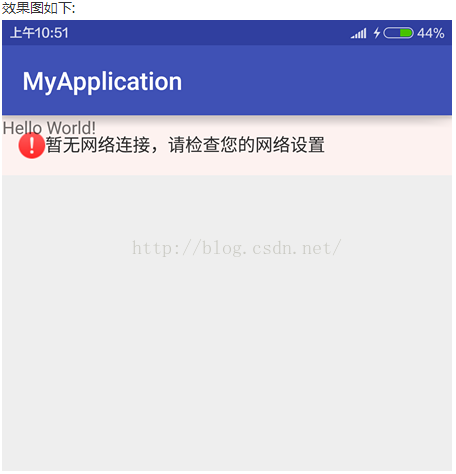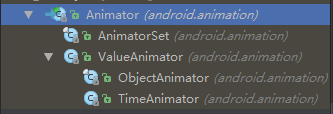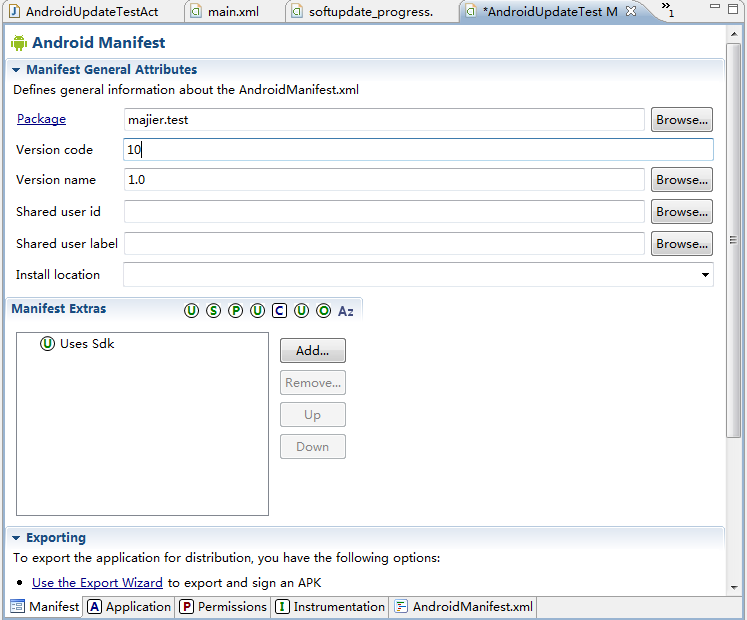編輯:關於Android編程
How you run your app depends on two things: whether you have a real Android-powered device and whether you're using Eclipse. This lesson shows you how to install and run your app on a real device and on the Android emulator, and in both cases with either Eclipse or the command line tools.
Before you run your app, you should be aware of a few directories and files in the Android project:
AndroidManifest.xml
The manifest file describes the fundamental characteristics of the app and defines each of its components. You'll learn about various declarations in this file as you read more training classes.
src/
Directory for your app's main source files. By default, it includes an Activity class that runs when your app is launched using the app icon.
res/
Contains several sub-directories for app resources. Here are just a few:
drawable-hdpi/
Directory for drawable objects (such as bitmaps) that are designed for high-density (hdpi) screens. Other drawable directories contain assets designed for other screen densities.
layout/
Directory for files that define your app's user interface.
values/
Directory for other various XML files that contain a collection of resources, such as string and color definitions.
When you build and run the default Android app, the default Activity class starts and loads a layout file that says "Hello World." The result is nothing exciting, but it's important that you understand how to run your app before you start developing.
Run on a Real Device
If you have a real Android-powered device, here's how you can install and run your app:
Plug in your device to your development machine with a USB cable. If you're developing on Windows, you might need to install the appropriate USB driver for your device. For help installing drivers, see the OEM USB Drivers document.
Enable USB debugging on your device.
On most devices running Android 3.2 or older, you can find the option under Settings > Applications > Development.
On Android 4.0 and newer, it's in Settings > Developer options.
Note: On Android 4.2 and newer, Developer options is hidden by default. To make it available, go to Settings > About phone and tap Build number seven times. Return to the previous screen to find Developer options.
To run the app from Eclipse, open one of your project's files and click Run from the toolbar. Eclipse installs the app on your connected device and starts it.
Or to run your app from a command line:
Change directories to the root of your Android project and execute:
ant debugMake sure the Android SDK platform-tools/ directory is included in your PATH environment variable, then execute:
adb install bin/MyFirstApp-debug.apkOn your device, locate MyFirstActivity and open it.
That's how you build and run your Android app on a device! To start developing, continue to the next lesson.
Run on the Emulator
Whether you're using Eclipse or the command line, to run your app on the emulator you need to first create an Android Virtual Device (AVD). An AVD is a device configuration for the Android emulator that allows you to model different devices.
Figure 1. The AVD Manager showing a few virtual devices.
To create an AVD:
Launch the Android Virtual Device Manager:
In Eclipse, click Android Virtual Device Manager from the toolbar.
From the command line, change directories to <sdk>/tools/ and execute:
android avdIn the Android Virtual Device Manager panel, click New.
Fill in the details for the AVD. Give it a name, a platform target, an SD card size, and a skin (HVGA is default).
Click Create AVD.
Select the new AVD from the Android Virtual Device Manager and click Start.
After the emulator boots up, unlock the emulator screen.
To run the app from Eclipse, open one of your project's files and click Run from the toolbar. Eclipse installs the app on your AVD and starts it.
Or to run your app from the command line:
Change directories to the root of your Android project and execute:
ant debugMake sure the Android SDK platform-tools/ directory is included in your PATH environment variable, then execute:
adb install bin/MyFirstApp-debug.apkOn the emulator, locate MyFirstActivity and open it.
 Android 網絡連接判斷並進行相關處理
Android 網絡連接判斷並進行相關處理
獲取網絡信息需要在AndroidManifest.xml文件中加入相應的權限。 1)判斷是否有網絡連接,沒有則進入網絡設置/***檢測網絡是否連接*@retur
 Android 動畫系列之屬性(Property)動畫詳解
Android 動畫系列之屬性(Property)動畫詳解
前言今天有時間來繼續寫寫屬性動畫。簡介眾所周知,屬性動畫是Android3.0版本開始的,一個東西的推出肯定是有它的道理的,那為什麼前面已經有逐幀和補間動畫了還要推出屬性
 Android ViewDragHelper完全解析 自定義ViewGroup神器
Android ViewDragHelper完全解析 自定義ViewGroup神器
一、概述在自定義ViewGroup中,很多效果都包含用戶手指去拖動其內部的某個View(eg:側滑菜單等),針對具體的需要去寫好onInterceptTouchEvent
 Android App實現應用內部自動更新的最基本方法示例
Android App實現應用內部自動更新的最基本方法示例
這只是初步的實現,並沒有加入自動編譯等功能。需要手動更改更新的xml文件和最新的apk。 共涉及到四個文件!一、客戶端AndroidU